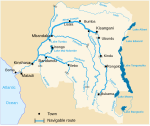|
Lualaba River The Lualaba River (Kongo: Nzâdi Luâlâmba, Swahili: Mto Lualamba) flows entirely within the eastern part of Democratic Republic of the Congo. It provides the greatest streamflow to the Congo River, while the source of the Congo is recognized as the Chambeshi. The Lualaba is 1,800 kilometres (1,100 mi) long. Its headwaters are in the country's far southeastern corner near Musofi and Lubumbashi in Katanga Province, next to the Zambian Copperbelt. CourseThe source of the Lualaba River is on the Katanga plateau, at an elevation of 1,400 metres (4,600 ft) above sea level. The river flows northward to end near Kisangani, where the name Congo River officially begins. From the Katanga plateau it drops, with waterfalls and rapids marking the descent, to the Manika plateau. As it descends through the upper Upemba Depression (Kamalondo Trough), 457 metres (1,499 ft) in 72 kilometres (45 mi). Near Nzilo Falls it is dammed for hydroelectric power at the Nzilo Dam. At Bukama in Haut-Lomami District the river becomes navigable for about 640 kilometres (400 mi) through a series of marshy lakes in the lower Upemba Depression, including Lake Upemba and Lake Kisale. Ankoro lies on the west bank of the Lualaba River, opposite its confluence with the Luvua River from the east. Some geographers call the combined river below this point the "Upper Congo".[1] Below Kongolo, the river becomes unnavigable as it enters the narrow gorge of Portes d'Enfer (Gates of Hell). Between Kasongo and Kibombo, the river is navigable for about 100 kilometres (62 mi), before rapids make it unnavigable again between Kibombo and Kindu (Port-Empain). From Kindu up to the Boyoma Falls at Ubundu, the stream is navigable again for more than 300 kilometres. The Boyoma Falls or Stanley Falls are made up of seven cataracts, over a stretch of 100 kilometres (62 mi) of the river, between Ubundu and Kisangani. The river's end is marked after the seventh cataract, near Kisangani, where it becomes the Congo River. The Lualaba River serves as the northern and western boundary of Upemba National Park, protecting habitats on the Kibara Plateau in Katanga Province of the southeastern Democratic Republic of the Congo. TributariesThe largest tributaries of the Lualaba River are:
Cities and towns Cities and towns along and near the Lualaba River include:
HistoryThe Lualaba River was once considered a possible source of the Nile, until Henry Morton Stanley journeyed down it and proved that it drained into the Atlantic Ocean.[2] Stanley referred to it as the Livingstone. "Had not Livingstone spoken of the river at Nyangwe as the Lualaba, I should not have mentioned the word except as a corruption by the Waguha of the Wenya term Lu-al-ow-wa..."[2]: 114, 135 French colonial governor Pierre Savorgnan de Brazza also explored the Lualaba. Notes
References
External linksWikimedia Commons has media related to Lualaba River. |
